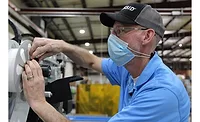Reducing Food Waste with Extended Shelf Life, Preservation Technologies

Reducing food waste is imperative for fighting world hunger, and technologies to reduce food waste can also help improve food safety and shelf life. Food wastage can also cause prices to rise, putting nutritious food out of the reach of the world's poorest. Based on World Health Organization (WHO) data, if the current trend of food loss and waste could be reversed, using advanced preservation and protection technologies, then enough spoiled food would be saved to feed two billion people—or three times the estimated 700 million people living in undernourished conditions today.
Making the food supply even more precarious this coming year is the added pressure on global food stocks that may lead to shortages of important foodstuffs. Both Ukraine and Russia are leading global producers of wheat, and Ukraine is well known as a global breadbasket and major exporter of vital staples. World food supplies were already tight before this year. If these two countries are unable to deliver their crops to global markets, it will be a challenging year to keep world populations fed. Reducing food waste by implementing innovative preservation technologies is more important than ever.
Extending Bread Shelf Life to Alleviate Pressure on Wheat Supply
Studies show that about 50 percent of consumer food waste can be prevented by extending the shelf life of the food product.1,2 According to the Food and Agriculture Organization of the United Nations (FAO), the average U.S. consumer wastes 10 times more food per year than consumers in Southeast Asia. In emerging markets, 60 percent of food waste occurs early in the supply chain—before it reaches the retailer—and can often be addressed by enhancing preservation practices. Enhanced food preservation and shelf life would also help improve the safety and quality of many food products.
Bread and baked goods represent the largest volume of processed food waste, while fresh produce comprises the highest volume overall. Importantly, baked goods offer a key opportunity for the industry to ensure that limited global wheat stocks will be utilized optimally. Advanced technologies—enzymes, organic acids, emulsifiers, fermented vinegars, and other bakery ingredients—can extend the shelf life of bread and also protect freshness while ensuring an appealing taste up to the last day of viable use. Aside from the positive benefit of avoiding waste, this also lowers distribution costs by reducing the frequency of restocking.
Reducing Wasted Meat Delivers More Protein for All
Meat is the most expensive and environmentally costly category of food waste, according to Statistica. Addressing its preservation challenges is critical for this coming year, given that rising food and feed prices will make protein more expensive everywhere. According to Kerry Group's proprietary research, meat is also the number-one category in terms of consumer concerns around food safety.
Looking for quick answers on food safety topics?
Try Ask FSM, our new smart AI search tool.
Ask FSM →
Meat safety concerns also extend to plant-based alternatives, as many consumers are unclear about how long these products remain fresh. Preservation technologies, including low- or no-sodium solutions, can extend the shelf life of plant-based meat and also move the product from the freezer to the refrigerator as a means of reducing costs. In terms of protecting meat, an integrated ("building block") approach developed with a preservative ingredient supplier can create an improved food preservation system that meets safety goals. Moreover, by reducing the volume of wasted meat, there is a positive environmental impact through reduced carbon dioxide emissions, water usage, and feed consumption. Solutions that can help protect and extend the shelf life of meat also deliver a positive impact on the environment.
Food Safety Implications of Targeting Food Waste
Unfortunately, food safety concerns can arise when manufacturers seek to aggressively reduce waste; this makes it vital for shelf life extension efforts to be validated by microbiological studies, and for all ingredients and processes to be regulator-approved, to ensure they are safe for human consumption. Sensory studies conducted with a preservation ingredient supplier ensure that changes deliver only positive impacts on taste and texture.
Through a concerted global effort, undernourishment is a solvable problem. Food and beverage producers can start now to reduce food waste and loss and help feed the entire world. Innovative preservation solutions are available to help reach this goal and reduce the environmental and social costs of wasted food. In light of National Stop Food Waste Day in the U.S. on April 27, consider making a proactive commitment at your organization to simultaneously reduce food waste, alleviate hunger, and encourage smarter food safety and quality practices.
References
- Kauffman, C. "Reducing Food Waste by Extending Product Life." WRAP UK. March 4, 2015.
- Martindale, W. "Using Consumer Surveys to Determine Food Sustainability." British Food Journal 116, no. 7 (July 2014).









